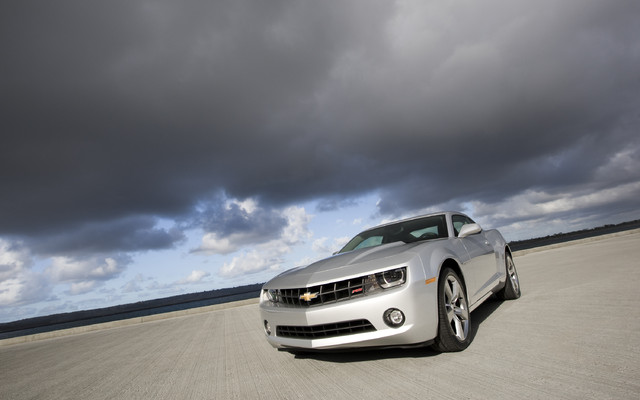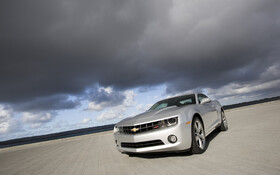2010 Camaro RS: Just Don't Tell Them It's a V6

| Strong points |
|
|---|---|
| Weak points |
|
When I turned 16, I wanted nothing more than a proper, honest-to-goodness muscle car. But, having last been produced decades earlier, they weren’t exactly populous in the municipality of Richmond, BC. Flipping through the local Buy & Sell would reveal just a few examples of decent muscle cars, and the majority of those would either be too rusted out, abused, or expensive for a high school student whose car fund came courtesy of a part-time gig at the local Canadian Tire.
But, two doors down in the direction that led to high school was my unicorn. A legitimate 1970 Camaro Z28 that had fallen into disuse, it taunted me with visions of epic burnouts, 12 second trap times and most importantly, a first generation LT1 to call my own. Unmolested and wearing the same wheels, tires, and paint (dark green with white stripes), the whole car was in amazingly good shape, and looked as if a solid week’s work would get it back in running order. Keeping it relatively clean and rust-free, the owner made no apparent attempts to get the car back on the road, but professed just such an intention whenever the topic of selling it came up. Which it did, as often as possible.
But, as is often the case, the owner was immovable. Actually, that’s a lie; shortly before I ponied up enough cash to wave what I thought would be a tempting wad under his nose, I came home to find the faded green Camaro being loaded up onto a flatbed, the owner taking it and the rest of his possessions to a new home elsewhere in the Vancouver area. After searching about for a replacement for the faded green Camaro and being sorely disappointed by the lack of worthy heirs to the dream car throne, I was approached by a co-worker who was forced to sell their own dream car so as to avoid eviction. Free uniforms aside, Canadian Tire’s remuneration schedule doesn’t exactly afford a luxurious lifestyle, and subsequently, his Camaro had to go. A 1983 model year Z28, it boasted absolutely none of the attractors that drew me to the 1970 Z28 I’d grown to love. No shapely sheetmetal, no aggressive vertical grille, no LT1 350 cubic inch V8, and no classic Chevrolet racing stripes. But, the price was right, and with a fresh coat of charcoal paint, it looked excellent. Low, lithe, and sinister with black wheels, tinted windows and a rumbling Flowmaster exhaust, it was the epitome of a teenager’s car.
This past summer, I signed the paperwork to transfer ownership of that Camaro over to another teenager who appeared to love it for all the same reasons. For all the work I’d put into it (a new and thoroughly uprated transmission, a new exhaust system, a rebuilt motor, a complete chromoly and rose jointed suspension system, and a coil-over conversion among other upgrade), I’d assumed I was done with owning a Camaro. Bearish in the wet, a cop magnet in the dry, and only capable of providing swift, comfortable travel for two partially-deaf occupants, my own experiences left me with mixed emotions when it came time to test the new 2010 Camaro RS.
Bearing a stronger resemblance to what is undeniably known as the most universally desirable Camaro (the 1969 Camaro SS), there’s a ton to be said for the 2010 Camaro’s looks... but the best summary came from a friend of mine that had never seen one until I drove into his driveway: it looks like a Hot Wheels car. With impossibly flared wheel arches, shelf-like rear quarter panels and a bunker-like greenhouse, the whole thing is the very definition of ridiculous. But, as with anything to do with muscle cars, chances are you’ve probably already formed your own opinion on the Camaros looks, so I’m going to stop talking about it.
But, although the Camaro’s looks may be subjective, its performance is anything but. While Mustang and Challenger fans enjoy a three-tiered product stepladder, Camaro aficionados are blessed with just two: V6 and V8. But while Mustang and Challenger V6 owners have to be comfortable in the knowledge that they own what most would call the “economy” version, Camaro V6 owners can sidle up to the next intersection knowing their powerplant is equal to their competitor’s V8s. That’s right; producing 304 horsepower, the 2010 Camaro V6 actually produces more power than last year’s V8-equipped Mustang GT. And it feels like it too; responding to throttle inputs without a moment’s hesitation and with surprising verve. Even when equipped with the Hydra-Matic automatic transmission, I often found myself shaking my head out of surprise as I watched the numbers on the speedometer climb with alarming alacrity. Hitting 60 miles per hour in just 6.1 seconds, it’s easily quick enough to avoid embarrassment, and to be honest, I was downright shocked by the real-world performance put up by the 3.6L powerplant. Expecting something more akin to the V6 rental specials of yore (visitors to Hawaii will know of the phenomenon of which I speak), the powertrain did a great job of supplying the torque I demanded without any undue movement or wasted effort. Step on the gas and there’s none of the wind-up of older automatic transmissions, no unnecessary engine revving, just instantaneous response.
Inside, the surprises continued. With a completely foreign layout, the Camaro’s interior bears out its Australian roots (It’s a 2-doored version of a certain Holden product we all know and love) and shuns standard GM switchgear. And that’s a good thing too, because this new GM stuff is fantastic. Once again, words obviously can’t do it justice, but the fact is, no one should be disappointed by the fit and finish of their Camaro. All the controls are perfectly placed, and all the tactile sensations you could ever want abound. It looks good too, with just the right amount of retro cues and modern touches. The seats are supportive and comfortable with a wide range of adjustment, but the steering wheel feels a little odd, with a semi-elliptical profile that feels weird in the hands. Of course, even with that weird wheel in your hands, you’ll still be the envy of your rear seat passengers. With an interior cabin that’s been moved as far back as possible, there isn’t a whole lot of room in the back. In fact, in my one week test, I utilized the rear seat once, and it was excruciating for everyone involved.
But no one buys one of these cars because they want a practical people hauler. No, those people buy minivans. But, for those that want the bad ass image without the dizzying fuel economy of the V8, the Camaro V6 offers a fantastic compromise. It offers stellar performance with the same head-turning looks as the V8 (in fact, with the RS appearance package, the V6 is almost identical to the V8), with a lower price tag. With independent suspension all around and decades’ worth of technology, it’s head and shoulders above any previous Camaro, and stands above more than a few competitors. Sure, it’s got its problems, but if we’re honest with ourselves, no one cares. It pushes all the right emotive buttons, and makes you feel like a kid again every time you twist the key. It’s perfect.






